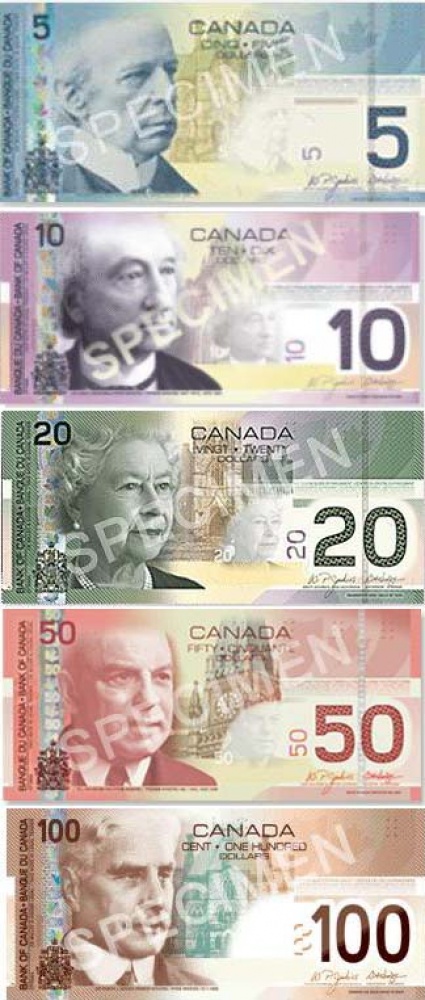April 22, 2010
The Art of Canadian Banknotes
Judith Maclean Miller
More by this author...
We Canadians carry banknotes around with us all the time, exchange them, handle them, but do we ever look at them?
The current banknotes in circulation are part of a series begun in 2001 called collectively, “Canadian Journey.” The faces of the bills, from $5 to $100, show images of Wilfrid Laurier, John A. Macdonald, Queen Elizabeth II, William Lyon Mackenzie King, and Robert Borden. On the backs of the bills are collages which include quotations from literature as well as reproductions of Canadian art pieces. All literary excerpts on the bills are in both French and English.
The $5 bill celebrates Canadian winter and includes the lines
The winters of my childhood were long, long seasons. We lived in three places—the school, the church, and the skating-rink—but our real life was on the skating-rink.
[Roch Carrier’s short story “The Hockey Sweater,” from The Hockey Sweater and Other Stories]
Roch Carrier (1937-) is a well-regarded Quebecois writer, and his collection of stories follows small boys growing up in a Quebec town. The NFB made a popular film of the title story. This collage gathers pictures of children playing winter sports among snowy trees. One of the young hockey players wears a jersey with #9 on the back. It was the number of the famous Maurice (The Rocket) Richard who played for the Montreal Canadiens, a central presence in Carrier’s story.
The $10 bill features lines from a familiar poem, surrounded by images of soldiers, remembrance and a war memorial.
In Flanders Fields the poppies blow
Between the crosses, row on row,
That mark our place, and in the sky
The larks, still bravely singing, fly
Scarce heard amid the guns below.
[“In Flanders Field,” John McCrae (1872-1918)]
John McCrae was a doctor and himself a soldier in the first World War. The poem has been memorised by many Canadian school children and is often recited on Remembrance Day. A copy of it hangs in the foyer of the Royal Victoria Hospital in Montreal, in honour of McCrae, who was part of its medical staff.
The $20 bill includes a question from a novel by Gabrielle Roy (1909-1983), La Montagne secrète (The Hidden Mountain).
Could we ever know each other in the slightest without the arts?
Roy is a famous Quebecoise writer, born in Manitoba but for many years resident in Quebec. She is perhaps best known in English Canada for her novel The Tin Flute.
The visual artist celebrated on this banknote is Bill Reid, with photographs of two of his sculptures, Raven and the First Men and The Spirit of Haida Gwaii. These pieces acknowledge Reid’s Haida heritage and the importance to Canadians of that art tradition. There are two bronze castings of The Spirit of Haida Gwaii. One in black bronze in Washington, D.C. sits outside the Canadian embassy and one in green bronze is in the Vancouver International Airport. There is also a plaster copy in the Museum of Civilisation in Gatineau, Quebec. Figures from Haida mythology fill a traditional Haida dugout canoe, with the Raven—or Trickster—holding the steering oar.
The $50 bill includes a statement from Article 1 of the Universal Declaration of Human Rights, (1948):
All human beings are born free and equal in dignity and rights.
Appropriately, the visual art presents “The Famous Five,” Barbara Paterson’s larger than life bronze sculpture of five women celebrating the Persons Case, of 1929. It was first placed in Calgary and in 2000, a replica was unveiled on Parliament Hill—the only sculpture there of a Canadian woman. The only one by a Canadian woman. The figures are Emily Murphy, Henrietta Muir Edwards, Louise McKinney, Irene Parlby and Nellie McClung, social and political activists, shown as they might have been on hearing the news of the British Privy Council’s ruling that women are “persons” and therefore eligible to sit in the Canadian Senate. Barbara Paterson is an Albertan who has exhibited her work widely, from Bulgaria to Singapore.
On this same bill, a volunteer medal is shown, commemorating Thérèse Casgrain, a Montrealer who was an extraordinary activist and leader in areas of human rights for many groups in Canadian society. She became a member of the Senate one year before she turned 75 and had to resign. In 1980 she was given the title Grande Montréalaise in recognition of her work.
Anyone happening to handle a $100 note will see that it too quotes a poem:
Do we ever remember that somewhere above the sky in some child's dream perhaps Jacques Cartier is still sailing, always on his way always about to discover a new Canada? [“Jacques Cartier in Toronto,” by Miriam Waddington (1917-2004)]
An insightful and lively poet, Miriam Waddington was born in Winnipeg, lived for many years in Montreal, where she was an important part of the English language literary scene, and then moved to Toronto, where she taught Canadian literature at York University.
Visual themes in Canadian exploration complement Waddington’s lines, including a map drawn by Samuel de Champlain (c.1580-1635), a French explorer of North America, “the father of New France,” along with a canoe that would have been used in his era, as well as a telecommunications antenna, the RADARSAT-1 satellite and a satellite image of Canada.
Each of these small pieces of paper, a Canadian banknote, celebrates some aspect of Canadian life and heritage, while each is, itself, a piece of art. The designs for the “Canadian Journey”series were completed by design teams at Canadian Bank Notes (CBN) and BA International, led by Jorge Peral, Artistic Director at CBN.







